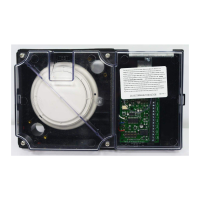16
4. Locate air duct detectors/sensors on branch lines if close identification of
the alarm source is required.
5. Locate air duct detectors/sensors on the downstream side of filters to sense fire
in filters. However, should the filters block, sufficient air flow may not be
available for proper air duct detector/sensor operation. See Figure 11.
DETE
T
R
EN
EXHAUST
FRESH
AIR
INTAKE
RETURN
AIR
SUPPLY
AIR
DO NOT LOCATE
DETECTOR/
SENSOR HERE
RETURN AIR
DAMPER
DETECTOR/SENSOR
O.K.
FILTER
BANK
EXHAUST
DAMPER
DO NOT LOCATE
DETECTOR/SENSOR HERE
Figure 11. Duct Housing Placement - Location of Dampers
6. Whenever possible, locate air duct detectors/sensors where they can be
conveniently observed and readily serviced.
7. Locate the air duct detectors/sensors in return air ducts ahead of mixing
areas.
8. Do not locate air duct detectors/sensors next to outside air inlets unless you
want to monitor smoke entry to the handling system from an adjacent area.
9. Locate air duct detectors/sensors upstream of air humidifiers and cooling
coils.
1. Tape the template (Figure 18) on the duct surface as shown in Figure 12.
Note: Do not position the Template with edges angled with respect to air flow
direction (Figure 12).
2. Drill two 1 1/4 inch (31.75 mm) holes (marked “A” in Figure 18) as located
by the template. Remove template after holes have been drilled.
3. If the duct is more than 3 feet (0.9 m) wide, then punch a 1-inch (25.4 mm)
hole in the duct wall directly opposite the upstream 1 1/4 inch (31.75 mm)
hole. See Figure 13. This hole is used to support the inlet tube.
Continued on next page
Installation, Continued
Rules to Follow (continued)
Duct Detector/Sensor
Installation
Technical Manuals Online! - http://www.tech-man.com

